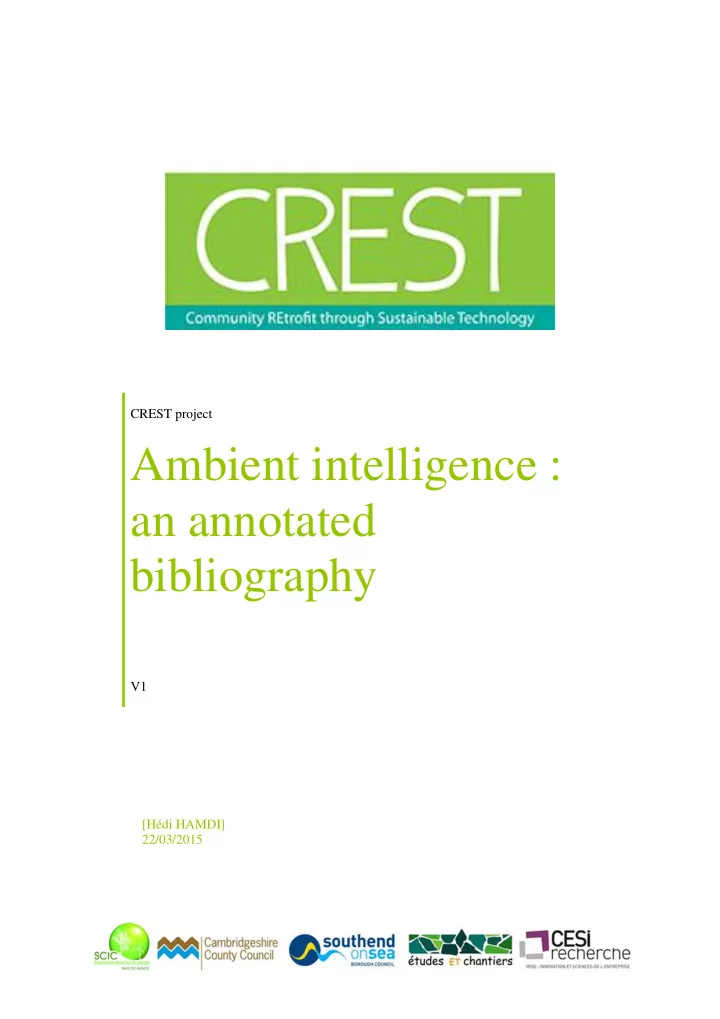

CREST project Ambient intelligence : an annotated bibliography V1 [Hédi HAMDI] 22/03/2015
Contenu But du document ............................................................................................. Erreur ! Signet non défini. 1. Introduction ..................................................................................................................................... 2 2 Ambient intelligence applications ................................................................................................... 8 2.1 Samrt home ............................................................................................................................. 8 2.2 Domestic care, assisted living ................................................................................................ 17 2.2.1 RoboCare Project .......................................................................................................... 17 2.2.2 Georgia Institute of Technology - Aware Home Research initiative (AHRI) ............... 19 2.2.3 Event-Condition-Action (ECA) Rules for Smart Homes for elderly care ..................... 23 2.2.4 Abductive Logic Programming for Smart Homes for Elderly Care .............................. 24 2.3 EHealth care applications ...................................................................................................... 25 2.4 Shops, Shopping, Recommender Systems, Business applications ....................................... 27 2.5 Musems, Tourism, Groups ans institutions, Others .............................................................. 28 3 Other data management and AI techniques ................................................................................... 30 3.1 Context-Aware Data Management ........................................................................................ 30 3.2 Planning ................................................................................................................................. 31 3.3 Self Organization ................................................................................................................... 32 Embodied Systems – PEIS .................................................................................................... 33 3.4 3.5 Decision Trees ....................................................................................................................... 34 4 CONCLUSION ................................................................................................................................. 34 5 REFERENCES .................................................................................................................................. 35 Ambient intelligence : an annotated bibliography 1/38
Introduction AMBIENT INTELLIGENCE We survey the literature available on the topic of ambient intelligence (AmI) including its applications and some of the technologies it uses. We list a selection of key publications in the area, and provide a summary for each of the papers. Moreover, we discuss technologies used, we focus on ambient data management and artificial intelligence; for example planning, learning, event-condition-action rules, temporal reasoning, and agent-oriented technologies. The survey is not intended to be exhaustive, but to convey a broad range of applications, technologies, and technical challenges. 1. Introduction The term Ambient Intelligence (AmI) was coined by the European Commission, when in 2001 one of its Programme Advisory Groups, the European Community’s Information Society Technology (ISTAG), launched the AmI challenge [1], later updated in 2003 [2]. But although the term AmI originated in Europe, its usage and intended goals have been adopted worldwide, with many related projects and research programs in recent years. This very active area has been the subject of several collections of papers, and special issue publications (e.g. [3], [4], [5], [6], IEEE Intelligent Systems Magazine, Journal of Ambient Intelligence and Smart Environments (JAISE)) and several specialized workshops and conferences. Some examples are: the European Conference on Ambient Intelligence which its sixth edition will be held in Athens (Greece) on 11-13 November 2015, the International Conference on Ubiquitous Robots and Ambient Intelligence, running for the past 11 years and which its eleventh edition was held in Kuala Lumpur, Malaysia on 12-15 November 2014, the International Conference on intelligent environnements which its eleventh edition will be held in Prague, Czech Republic on 15-17 July 2015. Ambient Intelligence is the vision of a future in which environments support the people inhabiting them. This envisaged environment is unobtrusive, interconnected, adaptable, dynamic, embedded, and intelligent. In this vision the traditional computer input and output media disappear. Instead processors and sensors are integrated in everyday objects. So for example, instead of using mice, screens, and keyboards, we may communicate Ambient intelligence : an annotated bibliography 2/38
Introduction directly with our clothes, household devices, and furniture, and these may communicate with each other and with other people’s devices and furniture. The envisioned AmI environment is sensitive to the needs of its inhabitants, and capable of anticipating their needs and behavior. It is aware of their personal requirements and preferences, and interacts with people in a user-friendly way, even capable of expressing, recognizing and responding to emotion. Most authors broadly share similar views of the features required for AmI applications. [7] identifies AmI as an intelligent, embedded, digital environment that is sensitive and responsive to the presence of people. The key features here are intelligence and embedding. By intelligence, he means the system is sensitive to context, is adaptive, learns from the behavior of users, and eventually, recognizes and expresses emotion. By embedding he means small, possibly minituarized devices that merge into the background of people ’ s activities and environments. Similarly, [8] identifies five related key technology features: embedded, context aware, personalized, adaptive, and anticipatory. The AmI environment is based on miniaturized and low-cost hardware, providing complex networks of heterogeneous information appliances or smart artifacts. These, individually or as an ensemble, can assist users in day-to-day or exceptional activities. They can demonstrate common sense and problem-solving ability, and assume responsibility for certain need, of the user, such as monitoring, alerting and helping users in their tasks. Advances in AmI are facilitated by the long-term increases in the power of microprocessors and nanotechnology, as well as the cost-efficiency of storage capacities and communication bandwidths. Some of the more modest visions of AmI are near to realization, and others look more like science fiction for now. But the scope of potential applications is vast, and in this survey we look at many. AmI has the potential of freeing people from tedious regular routine tasks. It can provide assistance in many circumstances. For example parents may never loose track of their children in crowds, because of location sensors and miniature communication devices sewn into the fabric of clothes. Blind people may be guided in unfamiliar environments by intelligent signposts and public transport timetables that may communicate via wireless headsets [9]. Our washing machines may query our dirty clothes for the required washing programs. Traditional memory aids can remind the user about activities on their daily schedule, but more sophisticated memory aids, on the other hand, can be context- sensitive. They can observe the user in their activities, guess their desired tasks and on that basis issue reminders Ambient intelligence : an annotated bibliography 3/38
Recommend
More recommend